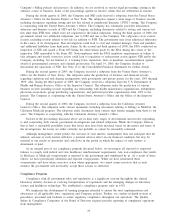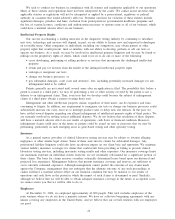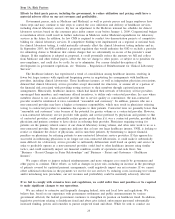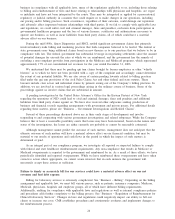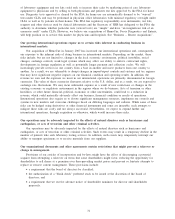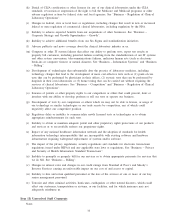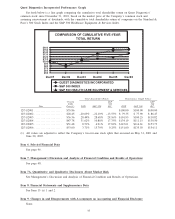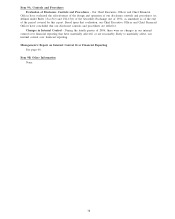Quest Diagnostics 2006 Annual Report Download - page 50
Download and view the complete annual report
Please find page 50 of the 2006 Quest Diagnostics annual report below. You can navigate through the pages in the report by either clicking on the pages listed below, or by using the keyword search tool below to find specific information within the annual report.We have obtained ratings on our debt from Standard and Poor’s and Moody’s Investors Service. There can
be no assurance that any rating so assigned will remain for any given period of time or that a rating will not be
lowered or withdrawn entirely by a rating agency if in that rating agency’s judgment future circumstances
relating to the basis of the rating, such as adverse changes in our Company or our industry, so warrant. If such
ratings are lowered, the borrowing costs on our senior unsecured revolving credit facility, secured receivables
facility and term loan would increase. Changes in our credit ratings do not require repayment or acceleration of
any of our debt.
We, or our subsidiaries, may incur additional indebtedness in the future. Our ability to make principal and
interest payments will depend on our ability to generate cash in the future. If we incur additional debt a greater
portion of our cash flows may be needed to satisfy our debt service obligations and if we do not generate
sufficient cash to meet our debt service requirements, we may need to seek additional financing. In this case, it
may be more difficult, or we may be unable, to obtain financing on terms that are acceptable to us. As a result,
we would be more vulnerable to general adverse economic, industry and capital markets conditions as well as the
other risks associated with indebtedness.
Failure to provide a higher quality of service than that of our competitors could have a material adverse
effect on our net revenues and profitability.
While there has been significant consolidation in recent years in the clinical laboratory testing business, it
remains a fragmented and highly competitive industry.
We primarily compete with three types of laboratory providers – hospital-affiliated laboratories, other
independent clinical laboratories and physician-office laboratories. Hospitals generally maintain an on-site
laboratory to perform testing on their patients. In addition, many hospitals compete with independent clinical
laboratories for outreach (non-hospital patients) testing. Most physicians have admitting privileges or other
relationships with hospitals as part of their medical practice and many hospitals leverage their relationships with
community physicians and encourage the physicians to send their outreach testing to the hospital’s laboratory. In
addition, hospitals that own physician practices generally require the physicians to refer tests to the hospital’s
laboratory. As a result of this affiliation between hospitals and community physicians, we compete against
hospital-affiliated laboratories primarily based on quality of service. Our failure to provide service superior to
hospital-affiliated laboratories and other laboratories could have a material adverse effect on our net revenues and
profitability.
Compliance with the HIPAA security regulations and privacy regulations may increase our costs.
The HIPAA privacy and security regulations, which became fully effective in April 2003 and April 2005,
respectively, establish comprehensive federal standards with respect to the uses and disclosures of protected health
information by health plans, healthcare providers and healthcare clearinghouses, in addition to setting standards to
protect the confidentiality, integrity and availability of protected health information. See “Business – Privacy and
Security of Health Information; Standard Transactions.”
We have implemented practices to meet the requirements of the HIPAA privacy and security regulations, as
required by law. The privacy regulations establish a “floor” and do not supersede state laws that are more
stringent. Therefore, we are required to comply with both federal privacy regulations and varying state privacy
laws. In addition, for healthcare data transfers from other countries relating to citizens of those countries, we
must comply with the laws of those other countries. The federal privacy regulations restrict our ability to use or
disclose patient-identifiable laboratory data, without patient authorization, for purposes other than payment,
treatment or healthcare operations (as defined by HIPAA), except for disclosures for various public policy
purposes and other permitted purposes outlined in the privacy regulations. The privacy and security regulations
provide for significant fines and other penalties for wrongful use or disclosure of protected health information,
including potential civil and criminal fines and penalties. Although the HIPAA statute and regulations do not
expressly provide for a private right of damages, we also could incur damages under state laws to private parties
for the wrongful use or disclosure of confidential health information or other private personal information.
We are actively in the process of completing systems planning for compliance with HIPAA regulations on
adoption of NPI, which becomes effective on May 23, 2007. See “Business – Privacy and Security of Health
Information; Standard Transactions”. We have obtained NPIs for all of our laboratory facilities and we have
updated our billing systems so that we can report our NPIs to Medicare, Medicaid and other commercial health
plans. We are in the process of obtaining NPI information from our physician clients, and expect that the process
will continue up to and beyond May 23, 2007. As of February 27, 2007, CMS reports that approximately 60% of
29






